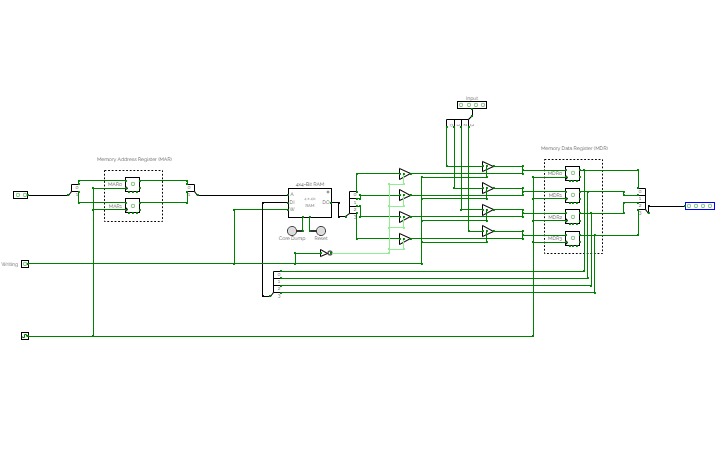[CSCA] Combinational Logic Circuits
[CSCA] Combinational Logic CircuitsCombinational logic circuits discussed in the Computer Science and Computer Architectures [CSCA] course at the University of Applied Sciences CAMPUS 02, Graz, Austria.
The project features the following circuits:
- XOR Gate - developed by using the basic logic gates.
- Half-Adder - developed by using the XOR Gate. [learn more]
- Full-Adder - developed by using Half-Adders. [learn more]
- Comparator - developed by using the XOR Gate.
- Shifter - developed by using the basic logic gates.
- Multiplexer - developed by using the basic logic gates. [learn more]
- Demultiplexer - developed by using the basic logic gates. [learn more]
- Decoder - developed by using the basic logic gates. [learn more]
- Arithmetic-Logic Unit (ALU) - developed by using the basic logic gates, Decoder, and a Full-Adder. [learn more]
[CSCA] Counters and Timing Signals
[CSCA] Counters and Timing SignalsCounters and timing signal generators discussed in the Computer Science and Computer Architectures [CSCA] course at the University of Applied Sciences CAMPUS 02, Graz, Austria.
The project features the following circuits:
-
Sample 2-Bit Counter - a simple counter exploratory developed by students during the lectures.
- Sample 2-Bit Counter with Timing Signals - that simple counter extended with decoder to provide timing signals.
- 2-Bit Switch-Tail Ring Counter - developed by using D flip-flops.
- 2-Bit Johnson Counter - developed by extending the 2-Bit Switch-Tail Ring Counter with decoder to provide timing signals.
- 4-Bit Switch-Tail Ring Counter - developed by extending the 2-Bit Switch-Tail Ring Counter with two more D flip-flops. [learn more (see chapters at the bottom of the page)]
- 4-Bit Johnson Counter - developed by extending the 4-Bit Switch-Tail Ring Counter with decoder to provide timing signals. [learn more (see chapters at the bottom of the page)]
[CSCA] Registers and Memory
[CSCA] Registers and MemoryRegisters and memory elements discussed in the Computer Science and Computer Architectures [CSCA] course at the University of Applied Sciences CAMPUS 02, Graz, Austria.
The project features the following circuits:
- 4-Bit Register - developed by using D flip-flops.
- 4-Bit Register (Enabling the Clock Signal) - 4-Bit Register with enabling of the register implemented via enabling of the clock signal.
- 4x4-Bit Memory - with read and write access and reading buffer set to zeros in case of writing.
- Tri-State Buffers - explains the tri-state buffer element.
-
Mutually Exclusive Tri-State Buffers - demonstrates how to use tri-state buffers to mutually exclude parts of a circuit.
- 4x4-Bit Memory with Tri-State Buffers - developed by extending the 4x4-Bit Memory with Tri-state buffers to cut of the reading buffer in case of writing.
- 4x4-Bit Memory with MAR and MDR - developed by extending the 4x4-Bit Memory with Tri-State Buffers with the Memory Address Register (MAR) and Memory Data Register (MDR).
- 4x4-Bit Random Access Memory (RAM) - demonstrates using the built-in RAM element.
-
4x4-Bit Random Access Memory (RAM) with MAR and MDR - demonstrates using the built-in RAM element extended with the Memory Address Register (MAR) and Memory Data Register (MDR).
[CSCA] Logic Gates
[CSCA] Logic GatesLogic gates as discussed in the Computer Science and Computer Architectures [CSCA] course at the University of Applied Sciences CAMPUS 02, Graz, Austria.
The project features the following circuits:
- Basic Logic Gates - demonstrates behavior of the five basic logic gates. [learn more]
- Controlling Gates - demonstrates how signal propagation can be controlled by "opening" and "closing" the gates.
- Combining Gates - demonstrates how logic gates can be combined to implement an arbitrary boolean function. [learn more]
- 2-Bit Comparator - developed based on it's truth table by using the NOT, AND, and OR Gates.
- 2x2-Bit Comparator - developed by using the 2-Bit Comparator.
- 2-Bit Adder - developed by using the 2-Bit Comparator and basic logic gates. [learn more]
[CSCA] Latches and Flip-flops
[CSCA] Latches and Flip-flops
Latches and flip-flops as discussed in the Computer Science and Computer Architectures [CSCA] course at the University of Applied Sciences CAMPUS 02, Graz, Austria.
The project features the following circuits:
- SR Latch - demonstrates the behavior of an SR Latch. [learn more]
-
Clock - demonstrates the Clock Signal. [learn more]
- Clocked SR Latch - developed by bringing the Clock Signal to the SR Latch. [learn more]
- D Latch - demonstrates the behavior of a D Latch. [learn more]
- Clocked D Latch - developed by bringing the Clock Signal to the D Latch. [learn more]












